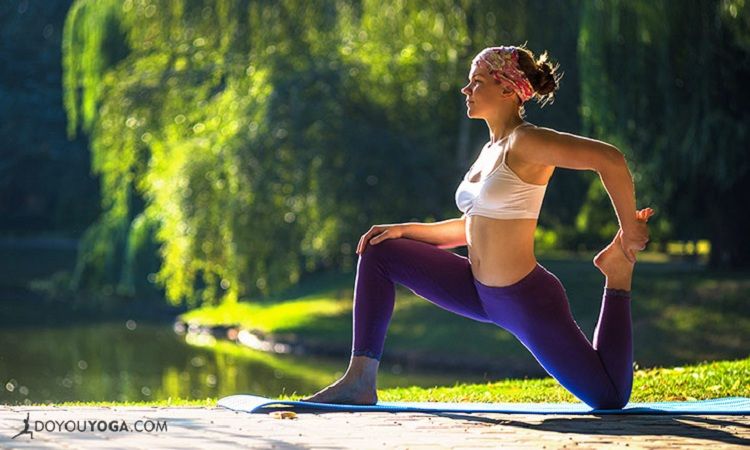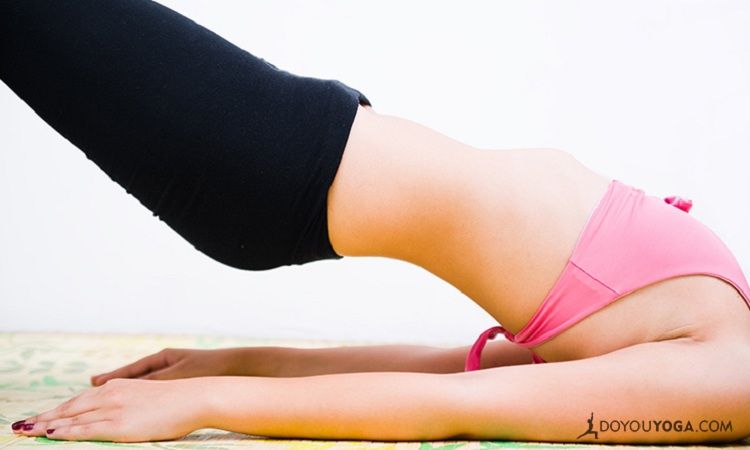Lizard pose can be a physically advanced posture for most students, which results in a deep stretch for the hip flexors and groin. When practiced mindfully, it can feel great. But I’ve also learned that sometimes, certain postures feel really good in the moment but not so good in the long run for my body. So when I practice deeper stretches like Lizard pose, I do so with the yogic principles of ahimsa and brahmacharya in mind.
Ahimsa translates as non-harming and brahmacharya as moderation of energy. To incorporate these into my practice, I’ve realized two solutions on my mat. First, I avoid long holds in poses and typically remain in a posture for only about three to five breaths, and almost never longer than a minute. Second, I explore what T.K. Desikachar refers to as counterposes—balancing the movement in certain intense poses with movements with the opposite energy.
Read on for tips on how to build a sequence around Lizard pose that will ensure that ahimsa and brahmacharya are upheld.
Warm-Up
It’s important to build some heat at the start of practice to bring some blood and warmth to muscles before we begin stretching them. Nothing does that better than Plank. It’s a total body strengthener, it’s simple, and when practiced well (don’t let your belly drop toward the mat and take knees-down option as needed), it’s very safe. I consider Plank to be a “do-every-day pose.”
Spend some time in Plank until you feel your body warm to a comfortable level. After holding for about a minute in Plank, I’ll often mix in Downward Dog and Child’s Pose. Play with this flow to start your practice; beginning with Plank, lifting your hips into Down Dog, and then releasing into Child’s pose. Hold each for a breath or two.
Ease Into Your Hips
After your body is warm, check in with your hips. I like to do this in Reclined Pigeon pose, also known as Eye of the Needle or Thread the Needle pose. To do this, come onto your back and place the outer ankle onto the top of the opposite knee. You can begin on either side. Reach behind that hamstring and draw the leg toward you. If you can’t reach behind that leg, try using a strap.
What’s most important here is to not overstretch. Come just as far as you need to in order to feel a gentle stretch in your hip, and then hold there for about three to five breaths. If you feel any sharpness, release from the pose.
Reclined Pigeon will allow you to gently stretch your hips and to awaken the area that will be engaged in your Lizard.
Balance the Body
It’s time to balance that stretch with some strength building. Come back onto hands and knees into tabletop position. Draw the belly to spine and imagine that you’re balancing a glass of water on your back. Gaze is down to protect the back of the neck.
Reach the right leg back to begin, parallel with the floor. You can stay right here, or if you’d like, reach the left arm forward. Hold for a few breaths. You’ll feel deep engagement in your core. Release and repeat on the opposite side. Return to table.
Ease In
Low Lunge is a great way to ease your body into lizard. I personally love using blocks in Low Lunge so if you’d like to try that, have two ready at the top of your mat.
From table, bring your right foot in between your hands. You can stay right here, with your hands on the mat, or perhaps bring your hands onto two blocks for stability. You’ll feel a nice stretch here in your left hip flexor. Remain for a few breaths, noticing how your hips feel today. Return to table and repeat on the opposite side.
Listen to your body. If this stretch feels like enough, perhaps you’ll forego Lizard today. If this feels great and you’d like to explore a bit more, prepare to move into Lizard.
Lizard Pose
From table, bring your right foot forward between your hands, just like you did in your Low Lunge. To move from Low Lunge into Lizard, side step your right foot toward the outside edge of your mat. Your right foot is now on the outside of your right hand. You can stay right here.
If you’d like, bring your forearms onto a block. This is my favorite expression of Lizard. Back toes can be tucked or released. Try both and see what feels best for you.
Others feel comfortable releasing their forearms to the mat. If you are hypermobile, it’s best to stay on the blocks. If it feels right for your body, release the forearms and enjoy this stretch. I personally don’t recommend long holds, so I’d advise staying here only for three to five breaths. Listen to your body and experiment to help you figure out what’s right for you. Repeat on both sides and return to table.
One More Counterpose
From tabletop, release into Child’s pose for a few breaths and then come to seated before you release down onto your back. Prepare for Bridge pose, a great counterpose for Lizard. Bend both knees and keep your feet about hip-width apart. If you want, you can also place a block there to engage your core. Your palms are face down on the mat at your sides.
Squeeze your glutes and then lift your bottom. Remember to keep your bottom engaged throughout to support your back. If you’d like, you can draw your hands together beneath your back, feeling your chest rise toward the sky. Hold Bridge for a minute, but if you’re new to this, work to your capacity and take breaks as needed.
Release into Savasana
As you leave Bridge, bring your body flat onto the mat, palms up and feet released toward the outer edge of the mat. Close your eyes, take a few breaths, and scan your body for any remaining tension. Let your exhales carry it away. Stay here for at least five minutes.
Lizard pose is a stretch that can be a fun exploration to introduce into your practice. Play with the pose and its counterposes. Notice if your left and right side feel different from one another. And last but not least, don’t forget to breathe deeply, feeling as if your breath is flowing into every cell in your body, bringing you into a state of complete and perfect balance.
Image credit: Dina Ivas










